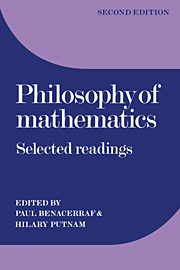Book contents
- Frontmatter
- Contents
- Preface to the second edition
- Introduction
- Part I The foundations of mathematics
- Part II The existence of mathematical objects
- Part III Mathematical truth
- Part IV The concept of set
- Russell's mathematical logic
- What is Cantor's continuum problem?
- The iterative concept of set
- What is the iterative conception of set?
- The concept of set
- Bibliography
What is Cantor's continuum problem?
Published online by Cambridge University Press: 05 June 2012
- Frontmatter
- Contents
- Preface to the second edition
- Introduction
- Part I The foundations of mathematics
- Part II The existence of mathematical objects
- Part III Mathematical truth
- Part IV The concept of set
- Russell's mathematical logic
- What is Cantor's continuum problem?
- The iterative concept of set
- What is the iterative conception of set?
- The concept of set
- Bibliography
Summary
The concept of cardinal number
Cantor's continuum problem is simply the question: How many points are there on a straight line in euclidean space? An equivalent question is: How many different sets of integers do there exist?
This question, of course, could arise only after the concept of “number” had been extended to infinite sets; hence it might be doubted if this extension can be effected in a uniquely determined manner and if, therefore, the statement of the problem in the simple terms used above is justified. Closer examination, however, shows that Cantor's definition of infinite numbers really has this character of uniqueness. For whatever “number” as applied to infinite sets may mean, we certainly want it to have the property that the number of objects belonging to some class does not change if, leaving the objects the same, one changes in any way whatsoever their properties or mutual relations (e.g., their colors or their distribution in space). From this, however, it follows at once that two sets (at least two sets of changeable objects of the space-time world) will have the same cardinal number if their elements can be brought into a one-to-one correspondence, which is Cantor's definition of equality between numbers. For if there exists such a correspondence for two sets A and B it is possible (at least theoretically) to change the properties and relations of each element of A into those of the corresponding element of B, whereby A is transformed into a set completely indistinguishable from B, hence of the same cardinal number.
- Type
- Chapter
- Information
- Philosophy of MathematicsSelected Readings, pp. 470 - 485Publisher: Cambridge University PressPrint publication year: 1984
- 31
- Cited by



